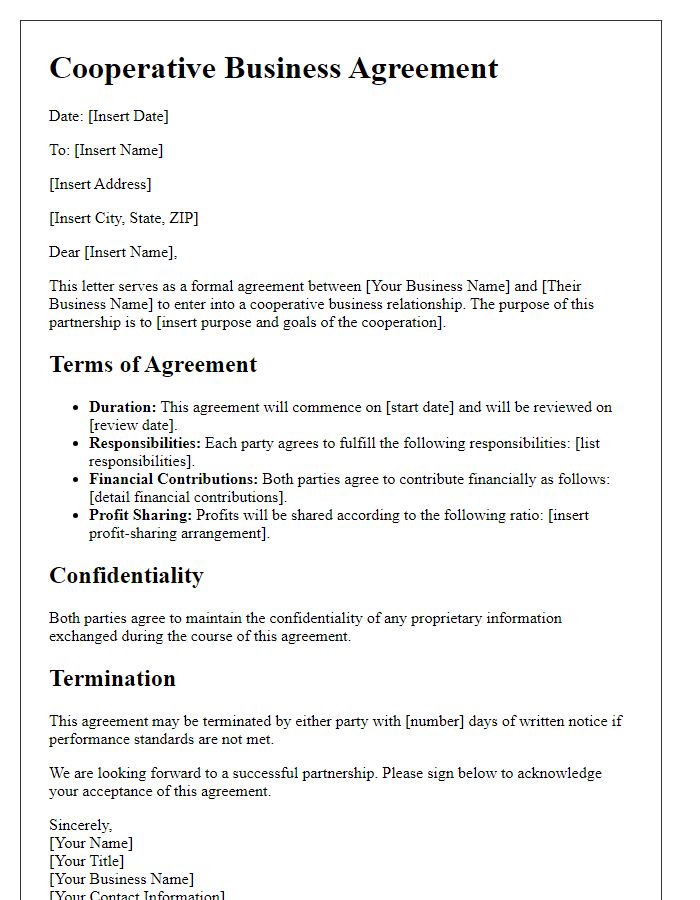Are you considering embarking on a strategic partnership that could elevate your business to new heights? Establishing a solid foundation through a well-crafted letter is crucial for setting clear expectations and fostering collaboration. In this article, we delve into essential elements to include in your strategic partnership agreement letter, ensuring both parties are aligned for success. Read on to discover valuable tips that can guide you through this important process!

Introduction and Purpose
A strategic partnership agreement involves collaboration between two or more entities aimed at achieving mutually beneficial goals. This agreement establishes the framework for cooperation, outlining terms for shared resources, specific objectives, and responsibilities that can enhance each party's market position. Companies utilize strategic partnerships to leverage complementary strengths, which may include technology, market access, and expertise, to drive innovation and growth. Establishing clear communication channels is crucial for successful alignment, ensuring each entity can contribute effectively to the partnership's success while addressing potential challenges and opportunities in the evolving market landscape.
Scope of Partnership
A strategic partnership agreement outlines vital components of collaboration between organizations, focusing on mutual benefits, shared goals, and defined scopes of partnership. This agreement often includes operational aspects such as resource sharing, financial commitments, and joint marketing strategies, emphasizing the alignment of business objectives and target markets. The duration of the partnership may be specified, typically spanning several years, with periodic reviews to assess performance and growth opportunities. Additionally, legal frameworks and intellectual property rights play crucial roles in safeguarding each party's interests while fostering innovation that drives competitive advantage. Clear communication channels and regular engagement plans enhance the partnership's effectiveness, ensuring both parties remain aligned on vision and outcomes.
Roles and Responsibilities
A strategic partnership agreement defines the roles and responsibilities of each organization involved, offering a framework for collaboration and mutual benefit. The primary entity responsible for project management may be designated as the lead organization, overseeing the execution of joint initiatives. Another partner may focus on resource mobilization, securing funding, and in-kind contributions to support project objectives. Each organization should outline specific duties, such as marketing, communication, and reporting, which may include regular updates on milestones achieved and performance metrics. Additionally, clear guidelines must be established for decision-making processes, conflict resolution, and the handling of intellectual property generated during the partnership. Each role should be detailed with timelines, expected outcomes, and accountability measures, ensuring that all parties contribute effectively to fulfill shared goals.
Confidentiality and Compliance
A strategic partnership agreement with a focus on confidentiality and compliance establishes essential guidelines for sharing sensitive information between collaborating entities, often referred to as parties. These parties could include two or more corporations, non-profit organizations, or governments working together on specific projects or objectives. Confidentiality clauses outline the protection of proprietary data, trade secrets, and any other confidential information that may be exchanged during the partnership. Compliance measures ensure adherence to applicable laws, including regulations such as the General Data Protection Regulation (GDPR) and industry-specific standards, which may vary based on context. Clear definitions of what constitutes confidential information, obligations of confidentiality, and duration of confidentiality must be included. Additionally, stipulating consequences for breaches of confidentiality alongside mechanisms for dispute resolution guarantees accountability and fosters a trustworthy environment for collaboration.
Termination and Amendment Conditions
A strategic partnership agreement outlines essential terms for collaboration between two parties, specifying conditions for termination and amendment. Termination conditions typically include mutual consent, breach of contract, and significant changes in circumstances, ensuring both parties can exit the agreement under defined circumstances. Amendment conditions address how changes to the agreement can be made, requiring written consent from both parties, proper notice periods (often 30 days), and documented justifications for any alterations. Clarity in these terms promotes trust and ensures stability within the partnership while adapting to evolving business environments.













Comments